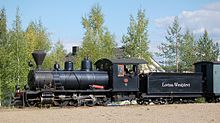Jokioinen – Forssa railway line
| Jokioinen-Forssa | |||||||||||||||||||||||||||||||||||||||||||||||||||||||||||||||||||||||||||||||||||||||||||||||||||||||||||||||||||||
|---|---|---|---|---|---|---|---|---|---|---|---|---|---|---|---|---|---|---|---|---|---|---|---|---|---|---|---|---|---|---|---|---|---|---|---|---|---|---|---|---|---|---|---|---|---|---|---|---|---|---|---|---|---|---|---|---|---|---|---|---|---|---|---|---|---|---|---|---|---|---|---|---|---|---|---|---|---|---|---|---|---|---|---|---|---|---|---|---|---|---|---|---|---|---|---|---|---|---|---|---|---|---|---|---|---|---|---|---|---|---|---|---|---|---|---|---|---|
|
Minko Railway Station
| |||||||||||||||||||||||||||||||||||||||||||||||||||||||||||||||||||||||||||||||||||||||||||||||||||||||||||||||||||||
| Route length: | 22.4 km | ||||||||||||||||||||||||||||||||||||||||||||||||||||||||||||||||||||||||||||||||||||||||||||||||||||||||||||||||||||
| Gauge : | 750 mm ( narrow gauge ) | ||||||||||||||||||||||||||||||||||||||||||||||||||||||||||||||||||||||||||||||||||||||||||||||||||||||||||||||||||||
|
|||||||||||||||||||||||||||||||||||||||||||||||||||||||||||||||||||||||||||||||||||||||||||||||||||||||||||||||||||||

The railway line Jokioinen-Forssa ( Finnish : Jokioisten rautatie (JR), Jokioisten-Forssan rautatie ) was a 22.4 km long narrow-gauge railway with 750 mm gauge in Finland . It led from the Humppila station of the state railway via Jokioinen to Forssa . Today the Jokioinen Museum Railway runs on the 14.2 km section from Jokioinen to Humppila.
history
The railway line was opened for occasional journeys on December 9, 1898. On October 25, 1899, the regular transport of people and goods began. It was the second publicly used private narrow-gauge railway in Finland.
Locomotives
Initially, two American tank locomotives (No. 1 and 2) were used, which had been built in 1897 by HK Porter in Pittsburgh , Pennsylvania . These locomotives were in service for more than 50 years until 1948. In 1900 another American steam locomotive was procured from Baldwin Locomotive Works (No. 3). The locomotive turned out to be too heavy for the rails with a meter weight of 17 kg / m of the small railroad and was therefore sold to Estonia . In 1922 a small tank locomotive was bought by Lokomo in Tampere , Finland. In 1937 a large tank locomotive was procured from Henschel & Sohn in Kassel . This had to be delivered to the Soviet Union in 1945 as a punishment for late reparation payments . As a replacement, two new locomotives were ordered from Ateliers Métallurgiques de Nivelles in Belgium . These locomotives were delivered in 1947 and 1948 and were given the numbers 4 and 5.
In the 1950s and 60s there were some Move 21 diesel locomotives operated by Valmet Aircraft Factory in Tampere, Finland. Originally they were made for the Russian reparations claims.
passenger traffic
The railway had three passenger cars made by the Hietalahti shipyard in Helsinki on bogies and frames from the Leeds Forge Company in England . From 1930 on, rail buses were used for passenger transport. The first rail bus ran from 1930 to 1932 and the second from 1932 to 1942.
Freight transport
There were about 100 freight cars. Most of these were made in England and Finland in the late 19th century and were in use from 1898 to 1974. In 1960, Loviisan – Vesijärven rautatie procured more freight wagons when it was shut down. Freight traffic was the main source of income during the industrialization of Jokioinen and Forssa. The best year for freight traffic was 1940, during the brief period of peace between the Winter War and the Continuation War , when a total of 90,000 tons of freight were transported. The record for passenger traffic was in the postwar period in 1945 when 402,254 passengers used the railroad.
In Forssa, from 1899 to 1973, the railway line was connected to an industrial railway electrified with 500 V, which opened up numerous industrial companies in the city with the same gauge. One of the locomotives manufactured by Siemens in Germany is in the inventory of the museum railway.
Decline
In the 1940s, the Jokioinen Railway increasingly faced competition from road traffic. The war slowed this competition, but within ten years passenger traffic ceased. The last passenger trains were taken out of service in 1954, and the railway company offered buses instead.
Freight traffic continued for over 20 years. The line was competitive for much longer than other Finnish narrow-gauge railways because it used trolleys from the 1930s onwards . The wagons of the Finnish state railway Valtionrautatiet with a gauge of 1.524 mm were transported piggyback without having to reload.
In the 1960s, the old age of the railway line made itself felt through wear and tear. The tracks and the vehicles were already more than 70 years old and high investment costs would have had to be incurred in order to withstand car and truck traffic.
The last commercial freight train ran from Humppila to Forssa on March 31, 1974. In the same year, seven kilometers of the route between Forssa and Jokioinen were demolished for scrapping. In 1975 the eight kilometer stretch between Minkiö and Humppila was torn down.
Jokioinen Museum Railway
The remaining seven kilometers between Minkiö and Jokioinen and the rebuilt eight kilometers between Minkiö and Humppila belong to the Jokioinen Museum Railway ( Finnish Jokioisten Museorautatie , JMR) and are used for the museum railway operation.
The museum was opened by the museum railway company Jokioisten Museorautatie Oy, founded for this purpose, on February 2, 1978, which four years after the line was closed, acquired the infrastructure of the line from Minkiö to Jokioinen with all its land and buildings. The first museum trains ran that same year. In 1994 the line was extended by eight kilometers between Minkiö and Humppila. The museum station is located next to the station of the standard-gauge railway line Turku-Toijala, so that the journey by train is easy. There is a museum there with a collection of historic narrow-gauge locomotives and cars, as well as other exhibits.
Individual evidence
- ↑ a b Matti Bergström, Erkki Einola, Olavi Kilpiö and Rautatiemuseoiden ja -harrastajien neuvottelukunta: Kapeat kiskot: Suomen yleiselle liikenteelle avatut yksityiset kapearaiteiset rautatiet . Ed .: Jokioisten museorautatie. 1993, ISBN 951-96543-1-3 (Finnish, The narrow-gauge public transport railways in Finland).
Web links
- History of Jokioinen Railway. jokioistenmuseorautatie.fi, 2018, accessed on November 11, 2018 .







